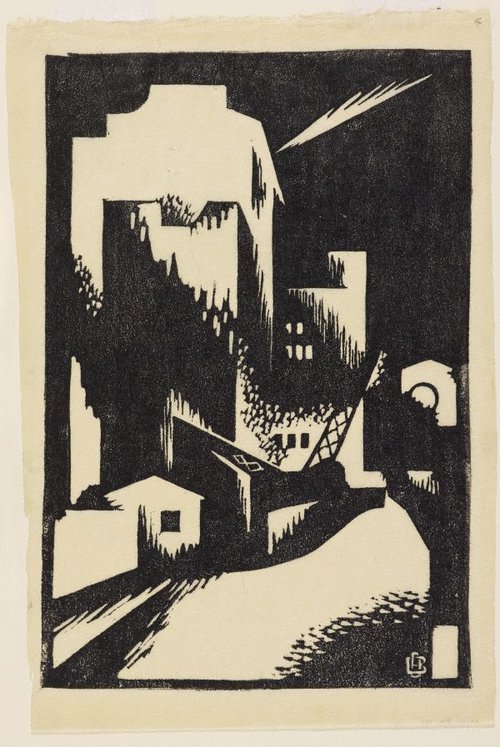-
Details
- Other Titles
- Still life, statuette
Chinese Statuette - Date
- 1929
- Media category
- Painting
- Materials used
- oil on canvas on paperboard
- Dimensions
- 55.2 x 38.3 cm board; 72.3 x 55.0 x 3.4 cm frame
- Signature & date
Signed l.l. corner, black oil "Dorrit Black". Not dated.
- Credit
- Purchased with the support of the Art Gallery Society of New South Wales through the Dagmar Halas Bequest 2014
- Location
- South Building, ground level, 20th-century galleries
- Accession number
- 608.2014
- Copyright
- Artist information
-
Dorrit Black
Works in the collection
- Share
-
-
About
The Adelaide-born Black arrived in Sydney in 1915 and studied under Julian Ashton and Elioth Gruner. During the 1920s she was increasingly focused on 'modernising' her practice and in 1927 travelled to Europe in order to acquire (in her own words) "a definite understanding of the aims and methods of the modern movement and in particular - the cubists". She initially studied linocut printing at the Claude Flight Grosvenor School in London before moving to Paris where she enrolled in the Academy of the Salon cubist André Lhote. Black also worked briefly with Albert Gleizes in 1929 prior to her return to Australia.
Black held her first solo show in Sydney at the Macquarie Galleries in 1930, exhibiting works that declared the cubist-inspired aesthetics that she had developed during her studentship overseas.
This exhibition included 'The Chinese statuette', a work that stands out as one of the artist's most exceptional and formally resolved still life paintings. The work reveals her understanding of Lhote's compositional principles of a geometric order where the fractured planes of cubist construction were ultimately integrated into a rhythmically driven whole. Yet the work also indicates Black's own developing aesthetic of a modelled realism that recedes into fragmented abstraction. Using the compositional structure of the prism, Black beautifully synthesises a sense of the solidity of the still life objects within the composition's geometric construction, achieving a unified model of both weight and abstraction.
-
Exhibition history
Shown in 7 exhibitions
Dorrit Black (1930), Macquarie Galleries, Sydney, 10 Sep 1930–20 Sep 1930
Dorrit Black (1938), Royal South Australia Society of Arts, Adelaide, 07 Jul 1938–23 Jul 1938
Contemporary Art Society Exhibition 1940, National Gallery of Victoria [Swanston Street], Melbourne, 09 Aug 1940–01 Sep 1940
Contemporary Art Society Exhibition 1940, David Jones' Art Gallery, Sydney, Sydney, 24 Sep 1940–24 Oct 1940
Dorrit Black Memorial Exhibition, Royal South Australia Society of Arts, Adelaide, 22 Apr 1952–02 May 1952
The art of Dorrit Black, Art Gallery of South Australia, Adelaide, 23 Jan 1976–22 Feb 1976
Australian, New Zealand, British and European, historical and contemporary drawings and paintings sculptures, Malvern Town Hall, Malvern, 23 Mar 1983–25 Mar 1983
20th-Century galleries, ground level (rehang), Art Gallery of New South Wales, Sydney, 20 Aug 2022–2023
-
Bibliography
Referenced in 7 publications
-
Leonard Joel, Australian, New Zealand, British and European, historical and contemporary drawings and paintings sculptures, Melbourne, Mar 1983, 122. lot no. 777; titled 'Chinese Statuette'
-
Macquarie Galleries, Canberra (Editor), Dorrit Black, 'Catalogue', Sydney, 1930, n.pag.. titled 'Still Life, Statuette'; cat.no. 8; priced 10 guineas
-
Ian North, The art of Dorrit Black, 'Catalogue', pg. 120-135, North Melbourne, 1979, 122. cat.no. 0.33
-
Royal South Australia Society of Arts, Dorrit Black Memorial Exhibition, 'Oil paintings', Adelaide, 1952, n.pag.. cat.no. 30; priced 15 guineas
-
Royal South Australia Society of Arts, Dorrit Black, 'Catalogue', Adelaide, 1938, n.pag.. cat.no. 6; priced 12 guineas
-
John Saxby, Look, 'A window opens on new stories about building the collection', pg. 26-28, Sydney, May 2015, 26, 28 (colour illus.).
-
Second annual exhibition: Contemporary Art Society, 'Catalogue', Sydney, 1940, n.pag.. cat.no. 8; priced 10 guineas
-





